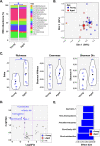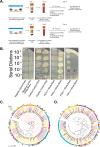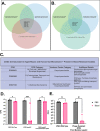Aging-Associated Augmentation of Gut Microbiome Virulence Capability Drives Sepsis Severity
- PMID: 37102874
- PMCID: PMC10294665
- DOI: 10.1128/mbio.00052-23
Aging-Associated Augmentation of Gut Microbiome Virulence Capability Drives Sepsis Severity
Abstract
Prior research has focused on host factors as mediators of exaggerated sepsis-associated morbidity and mortality in older adults. This focus on the host, however, has failed to identify therapies that improve sepsis outcomes in the elderly. We hypothesized that the increased susceptibility of the aging population to sepsis is not only a function of the host but also reflects longevity-associated changes in the virulence of gut pathobionts. We utilized two complementary models of gut microbiota-induced experimental sepsis to establish the aged gut microbiome as a key pathophysiologic driver of heightened disease severity. Further murine and human investigations into these polymicrobial bacterial communities demonstrated that age was associated with only subtle shifts in ecological composition but also an overabundance of genomic virulence factors that have functional consequence on host immune evasion. IMPORTANCE Older adults suffer more frequent and worse outcomes from sepsis, a critical illness secondary to infection. The reasons underlying this unique susceptibility are incompletely understood. Prior work in this area has focused on how the immune response changes with age. The current study, however, focuses instead on alterations in the community of bacteria that humans live with within their gut (i.e., the gut microbiome). The central concept of this paper is that the bacteria in our gut evolve along with the host and "age," making them more efficient at causing sepsis.
Keywords: aging; host-pathogen interaction; metagenomics; microbiome; sepsis.
Conflict of interest statement
The authors declare no conflict of interest.
Figures






Update of
-
Aging-associated augmentation of gut microbiome virulence capability drives sepsis severity.bioRxiv [Preprint]. 2023 Jan 11:2023.01.10.523523. doi: 10.1101/2023.01.10.523523. bioRxiv. 2023. Update in: mBio. 2023 Jun 27;14(3):e0005223. doi: 10.1128/mbio.00052-23. PMID: 36711447 Free PMC article. Updated. Preprint.
References
-
- Martin GS, Mannino DM, Moss M. 2006. The effect of age on the development and outcome of adult sepsis. Crit Care Med 34:15–21. doi:10.1097/01.ccm.0000194535.82812.ba. - DOI - PubMed
Publication types
MeSH terms
Grants and funding
LinkOut - more resources
Full Text Sources
Medical

